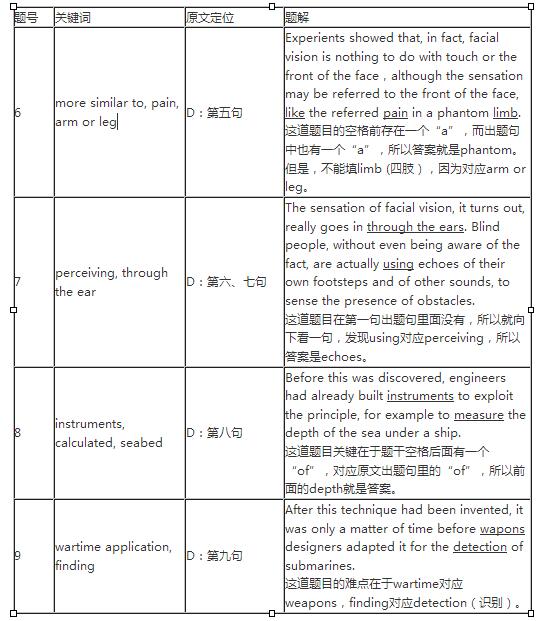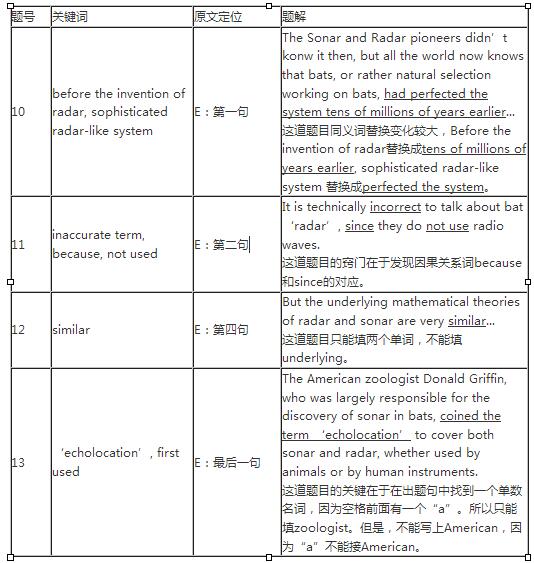剑桥雅思7阅读:Test1雅思阅读PASSAGE 1真题+答案+解析
发布时间:2020-11-13 关键词:剑桥雅思7阅读:Test1雅思阅读PASSAGE 1真题+答案+解析为帮助同学们学习,小编为大家整理了剑桥雅思7阅读:Test1雅思阅读PASSAGE 1真题+答案+解析,希望能够对大家有帮助。关于剑桥雅思的资讯关注新航道北京学校剑桥雅思栏目。
READING PASSAGE 1
You should spend about 20 minutes on Questions I- 13, which are based on Reading Passage 1below.
A Bats have a problem: how to find their way around in the dark.' They hunt at night, and cannotuse light to help them find prey and avoid obstacles. You might say that this is a problem of theirown making, one that they could avoid simply by changing their habits and hunting by day. Butthe daytime economy is already heavily exploited by other creatures such as birds. Given thatthere is a living to be made at night, and given that alternative daytime trades are thoroughlyoccupied, natural selection has favoured bats that make a go of the night-hunting trade.It isprobable that the nocturnal trades go way back in the ancestry of all mammals. In the time
when the dinosaurs dominated the daytime economy, our mammalian ancestors probably onlymanaged to survive at all because they found ways of scraping a living at night. Only after themysterious mass extinction of the dinosaurs about 65 million years ago were our ancestors ableto emerge into the daylight in any substantial numbers.
B Bats have an engineering problem: how to find their way and find their prey in the absence oflight. Bats are not the only creatures to face this difiulty today. Obviously the night-flying
insects that they prey on must find their way about somehow. Deep-sea fish and whales havelitll or no light by day or by night. Fish and dolphins that live in extremely muddy water cannotsee because, although there is light, it is obstructed and scattered by the dirt in the water. Plentyof other modern animals make their living in conditions where seeing is dfficult or impossible.C Given the questions of how to manoeuvre in the dark, what solutions might an engineer
consider?' The first one that might occur to him is to manufacture light, to use a lantern or asearchlight. Fireflies and some fish (usually with the help of bacteria) have the power to
manufacture their own light, but the process seems to consume a large amount of energy.
Fireflies use their light for attracting mates. This doesn't require a prohibitive amount of energy:a male's tiny pinprick of light can be seen by a female from some distance on a dark night, sinceher eyes are exposed directly to the light source itself. However; using light to find one's ownway around requires vastly more energy, since the eyes have to detect the tiny fraction of thelight that bounces off each part of the scene.The light source must therefore be immensely
brighter ifit is to be used as a headlight to illminate the path, than ifit is to be used as a signalto others. In any event, whether or not the reason is the energy expense, it seems to be thecase that, with the possible exception of some weird deep-sea fish, no animal apart from manuses manufactured light to find its way about.
D What else might the engineer think of? Well, blind humans sometimes seem to have an uncannysense of obstacles in their path. It has been given the name 'facial vision', because blind peoplehave reported that it feels a bit like the sense of touch, on the face. One report tells of a totallyblind boy who could ride his tricycle at good speed round the block near his home, using facialvision. Experiments showed that, in fact, facial vision is nothing to do with touch or the front ofthe face, although the sensation may be referred to the front of the face, like the referred painin a phantom limb.The sensation of facial vision, it turns out, really goes in through the ears,Blind people, without even being aware of the fact, are actually using echoes of their own
footsteps and of other sounds, to sense the presence of obstacles. Before this was discovered,engineers had already built instruments to exploit the principle, for example to measure thedepth of the sea under a ship. After this technique had been invented, it was only a matter oftime before weapons designers adapted it for the detection of submarines. Both sides in theSecond World War relied heavily on these devices, under such codenames as Asdic (British) andSonar (American), as well as Radar (American) or RDF (British), which uses radio echoes ratherthan sound echoes.
E The Sonar and Radar pioneers didn't know it then, but all the world now knows that bats, orrather natural selection working on bats, had perfected the system tens of millions of yearsearlier, and their 'radar' achieves feats of detection and navigation that would strike an engineerdumb with admiration. lt is technically incorrect to talk about bat 'radar', since they do not useradio waves. It is sonar. But the underlying mathematical theories of radar and sonar are verysimilar, and much of our scientific understanding of the details of what bats are doing has comefrom applying radar theory to them. The American zoologist Donald Grifin, who was largelyresponsible for the discovery of sonar in bats, coined the term 'echolocation' to cover bothsonar and radar, whether used by animals or by human instruments.
文章1
针对问题I- 13,你需要花费大约20分钟的时间。此题基于阅读下面的文章1。
蝙蝠有一个难题:如何在黑暗中找到路。“它们在夜间狩猎,不能使用光线来帮助它们寻找猎物和躲避障碍物。你可能会说,这是它们自己造成的问题,它们可以通过改变习惯和白天狩猎来避免这个问题。但是白天的经济已经被鸟类等其他生物严重剥削了。考虑到蝙蝠在夜间可以谋生,考虑到白天的替代贸易完全被占用,自然选择偏爱蝙蝠进行夜间狩猎贸易。夜间活动很可能可以追溯到所有哺乳动物的祖先。的时间
当恐龙统治了白天的经济时,我们的哺乳动物祖先可能只能在晚上找到谋生的方法才能生存。直到大约6500万年前恐龙神秘的大规模灭绝之后,我们的祖先才得以大量出现在日光下。
蝙蝠有一个工程问题:如何在没有光线的情况下找到它们的路和猎物。蝙蝠并不是今天面临这种困境的生物。显然,那些
它们捕食的昆虫必须以某种方式找到自己的路。深海鱼类和鲸鱼白天或晚上都没有光或没有光。生活在极其泥泞的水中的鱼和海豚看不见东西,因为虽然有光,但光被水中的污垢挡住了,而且被散射了。许多其他现代动物的生存环境是看不见或不可能的。c考虑到如何在黑暗中行走的问题,工程师有什么解决办法
考虑吗?“他首先想到的可能是制造灯,用灯笼或耳灯。萤火虫和一些鱼(通常是在细菌的帮助下)有能力
制造自己的光,但这个过程似乎要消耗大量的能量。
萤火虫用它们的光来吸引配偶。这并不需要过多的能量:在黑暗的夜晚,雄鱼的微小光点可以被雌鱼从距离处看到,因为她的眼睛直接暴露在光源下。然而;使用光线来寻找周围的路需要的能量,因为眼睛必须探测场景中每一部分反射的光线的极小部分。因此光源必须是巨大的
如果你把它当头灯来误导别人,要比把它当信号来误导别人更明亮。无论如何,不管原因是否与能源消耗有关,似乎有这样一个事实:除了一些奇怪的深海鱼类之外,没有任何动物能制造出光来找到自己的路。
D工程师还能想到什么?嗯,盲人有时似乎对他们的道路上的障碍有一种难以理解的感觉。它被称为“面部视觉”,因为据盲人报告,它在脸上的感觉有点像触觉。一份报告讲述了一个完全失明的男孩,他可以使用facialvision以很高的速度骑着三轮车在他家附近的街区里转。实验表明,事实上,面部视觉与触摸或脸的正面无关,尽管这种感觉可能与脸的正面有关,就像所谓的幻肢疼痛一样。事实证明,面部视觉的感觉是通过耳朵进入的,盲人甚至没有意识到这个事实,实际上是在使用他们自己的回声
脚步声和其他声音,以感觉存在的障碍。在这一发现之前,工程师们已经制造了利用这一原理的仪器,例如测量船下海洋的深度。在这项技术被发明之后,武器设计者将其应用于探测潜艇只是时间问题。在第二次世界大战中,双方都严重依赖于这些设备,代号为Asdic(英国)和声纳(美国),以及雷达(美国)或RDF(英国),使用无线电回声而不是声音回声。
E声纳和雷达的先驱者当时并不知道,但是现在全世界都知道,蝙蝠,或者更确切地说,蝙蝠身上发生的自然选择作用,在数千万年前就完善了这种系统,而且他们的“雷达”所具备的探测和导航功能,会让工程师目瞪口呆。从技术上讲,谈论蝙蝠“雷达”是不正确的,因为他们不使用无线电波。这是声纳。但是雷达和声纳的基本数学理论是相似的,我们对蝙蝠活动细节的大部分科学理解都来自于将雷达理论应用到它们身上。美国动物学家唐纳德·格里芬(Donald Grifin)对蝙蝠声呐的发现做出了重大贡献,他创造了“回声定位”一词来涵盖声呐和声呐
师资点题剑桥雅思7阅读:
READING PASSAGE 1
文章结构
体 裁:科普知识
主 题:从蝙蝠夜间觅食探索声纳和雷达的原理
段落概括
A蝙蝠在夜间活动的原因。
B其他不依靠光识路觅食的动物。
C人类以外的其他物种如何自己制造光。
D“面部视觉”原理以及根据此原理的发明。
E声纳和雷达的工作原理——“回波定位”。
师资点题剑桥雅思7阅读:
考题精解
Questions 1-5
『题型』MATCHING
『解析』

总结:本题型属于段落配信息题目。首先要通读全部题目,划出定位词。这种题型一般放在整篇最后做比较好,在细节题做完对文章已经有了的熟悉之后再来把握整体会更快。
Questions 6-9
『题型』填空题——SUMMARY题型
『解析』

Questions 10-13
『题型』填空题——完成句子
『解析』





